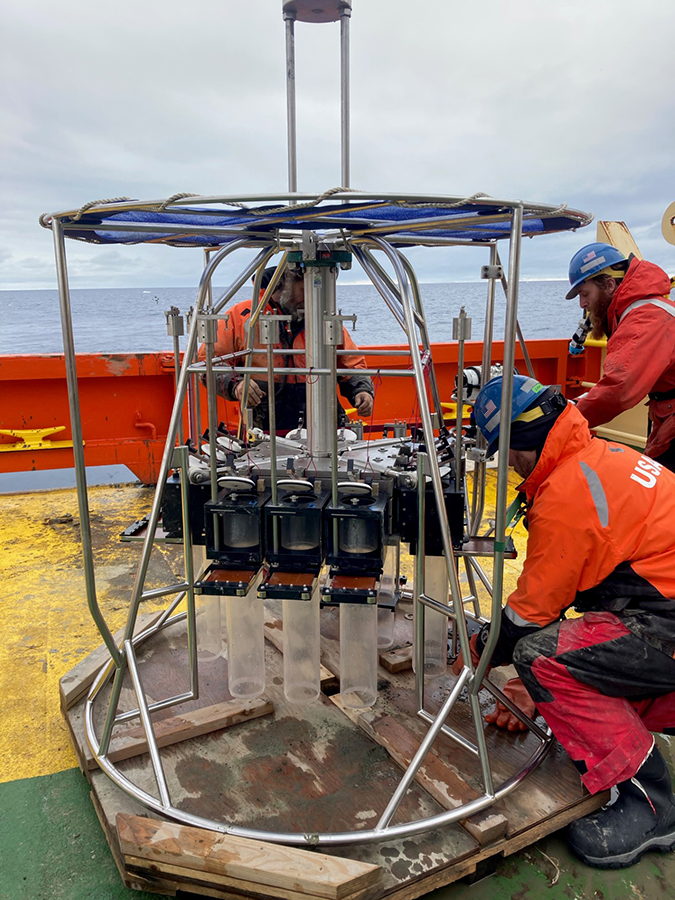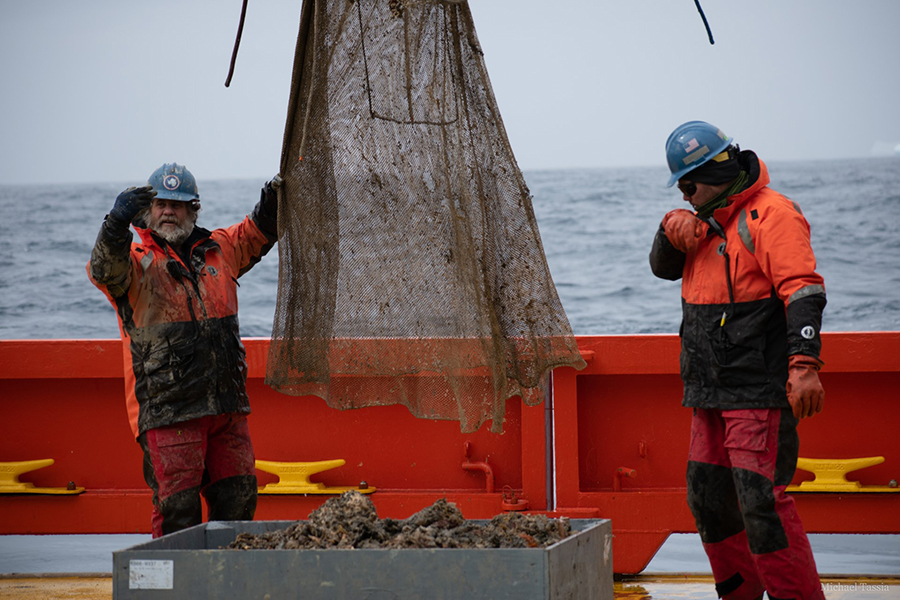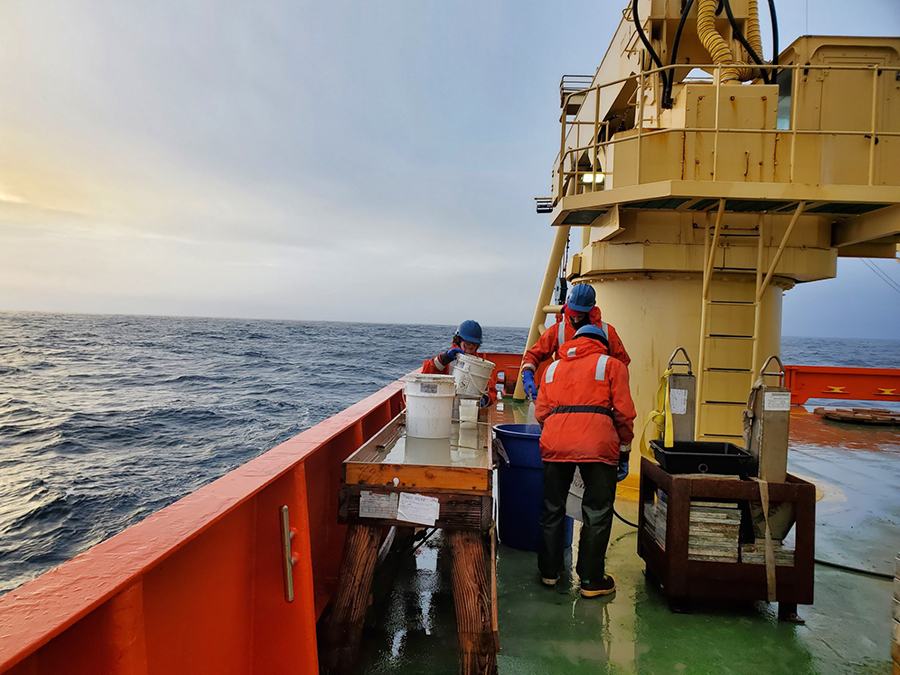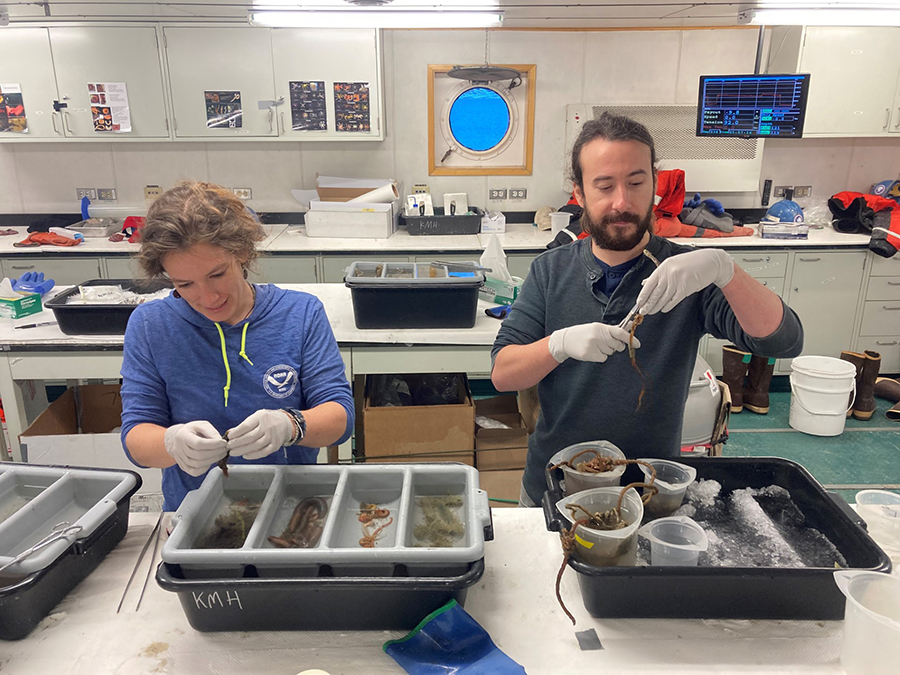Charting a Genetic Sea ChangeHow the DNA of Sea Creatures Contain a Coded Map of Ancient AntarcticaPosted March 15, 2021
Scientists are mapping the coastline of ancient Antarctica using DNA from underwater invertebrates alive today. 
Photo Credit: Ken Halanych
(Left to right) Rich Thompson, Colin Brayton and Alex Brett work to set up the Megacore sampler before it's dropped over the side of the ship to collect samples from the seafloor.
In October, despite the ongoing COVID pandemic, a team of researchers sailed from California to Antarctica to bring back the sea creatures with evidence of a long-lost transantarctic sea coded into their genes. The team is hoping to unravel a genetic mystery where some marine animals on opposite sides of the continent share more in common with each other, than with their relatives living in regions closer by. "We're trying to understand how animal populations have moved around over time," said Ken Halanych, a biologist at Auburn University and principal investigator on the project. "The goal is to understand if there have been historical connections between the Weddell and the Ross seas." Their research is supported by the National Science Foundation, which manages the U.S. Antarctic Program. Archipelago AntarcticaAntarctica today appears to be one vast, impenetrable continent, but this wasn't always the case. Much of the "land" there today are actually thick sheets of ice that stretch down to the seafloor. "It seems that the western Antarctic is more a series of islands than a landmass, so there are all these oceanic seaways passing through that region," Halanych said. Research by geologists indicates that the West Antarctic Ice Sheet, which covers roughly a third of the continent, has expanded and contracted significantly over millions of years and occasionally collapsed outright. "The last major ice shelf collapse, depending on who you talk to, was only 1.1 million years ago," Halanych said. "So we're talking about fairly recent timescales in terms of evolution." 
Photo Credit: Ken Halanych, Sheldon Blackman, Alex Brett
Brittle stars and other invertebrates line the seafloor of the Weddell Sea.
During these collapses, known as glacial minimums, Antarctica would have looked quite different. Ice sheets were vastly smaller, and shallow seas covered many regions now locked under thick glaciers, particularly throughout West Antarctica. "At the last glacial minimum, the transantarctic seaway was open, so you could literally take water [routes directly] from the Weddell Sea all the way to the Ross Sea," said Andrew Mahon, a biologist at Central Michigan University. How these creatures once moved about during these glacial minimums is especially relevant now as the climate changes, the continent warms and its ice starts to melt. "West Antarctica is the fasting warming place on the planet. We know that as climates warm or change, organisms move, and so one of the concerns here is that organisms are going to start shifting around in polar regions and in the quickly warming spots," Halanych said. "We're trying to understand historically where they've moved and where they've been. That's going to figure into some of our predictions about what might happen to the Antarctic." It's not just the Antarctic that is likely to see large animal migrations as the climate warms. The team hopes that this research can offer insights into the future of ecosystems around the globe. "Working that out in a place that's quickly warming will help us or should help us understand what's happening in other regions of the planet," Halanych said. "We can use this as a proxy to understand what is already starting to happen in other regions, temperate and tropical regions." 
Photo Credit: Michael Tassia
Rich Thompson (left) and Colin Brayton recover and unload samples from a Blake trawl that collected samples from the seafloor.
Mutant GeographyThe Weddell Sea is located east of the Antarctic Peninsula, while the Ross Sea lies on the far end of the continent, separated by the Transantarctic Mountains and hundreds of miles of solid ice sheets. Today, it's impossible for sea creatures to make their way directly from one sea to the other, but scientists have found that the creatures living in the two seas bear a striking resemblance to each other. "If the Ross and Weddell Seas are not connected, and haven't been connected, we would expect that things along the coast of the Antarctic to be more similar to each other and the Ross and the Weddell seas genetically very different, but that's not what we were getting," Halanych said. "For some things the Ross and the Weddell looked more closely related; things in the Bellingshausen and Amundsen seas [along the coast] looked a little more distantly related." Subtle genetic mutations happen naturally at a relatively predictable rate and can spread through a population over many generations as individuals interbreed. However, two populations separated from each other can't mix, so they'll start to exhibit distinct genetic signatures. These genetic differences will get compounded over time, and the two populations will diverge further the longer they are separated from each other. "You can look at the molecular differences between those individuals and actually quantify how different genetically two individuals are," Halanych said. Comparing the geography of genomes is a data-intensive operation. Genomes can be enormous, with fully-decoded DNA sequences consisting of several billions of nucleotides in some species. At the same time, to get a complete picture, the team needs to first compare the DNA of numerous specimens taken from the same region. This gives them an idea of how genetically diverse that population is naturally before comparing it to ones from distant areas. 
Photo Credit: Mike Lucibella
Today, Antarctica's Weddell and Ross seas are separated by a thick ice sheet, but a million years ago, the ice sheet was smaller and inland waterways likely made travel easier between the two seas.
"We're looking at thousands of mutations across the genome for each individual," Mahon said. "Each of these individuals will have a pattern and that pattern can then be compared to the pattern of mutations of those collected right near it versus those collected in different locations." Collecting the CodesTo run this comparison, the team needed as many specimens as possible from the Weddell Sea. McMurdo Station is located along the Ross Sea, so that region has been relatively well sampled, but data on the more remote Weddell Sea on the other side of the Antarctic continent is much sparser. "Sampling marine systems is a challenge. It's not like you're sampling terrestrial animals or animals in a stream where you can physically put eyes on stuff and say ‘oh that's it' and reach and pick it up," Halanych said. "When sampling in marine systems, we're largely doing it blind. We're putting a net or a piece of gear down, and we're hoping our animals are there." The team sampled several regions along the continental shelf. The creatures the team was looking for – namely sea stars, sea urchins and sea spiders – tend to thrive in water between about 200 and 500 meters deep. To collect them, they dropped special nets over the side of the ship and dragged them along the ocean floor, picking up sediment and animals from along the benthos. "Typically we use Blake trawls (it's a frame with a net) off the back of the ship," Mahon said. "We put the Blake trawl out, it goes down, we trawl, we bring it back up and we sort through whatever comes up." 
Photo Credit: Candace Grimes
Emily McLaughlin (left) and Kyle David (rear) work on processing and sieving sediment samples on the deck of the Nathaniel B. Palmer.
Once the trawl was pulled in, the team set about cataloging what they found and preserving their samples for later DNA sequencing. "Once the net comes on the ship that's when the real work for us starts. We sort all the animals into what we consider a ‘morpho-species,' – anything that looks like each other," Mahon said. The team then preserved what they collected in ethanol or froze them at minus 80 degrees Celsius. This protected the samples' DNA for the months it takes to arrive at the team's home labs where they'll extract the genetic information within. Even under the best of circumstances, it's a long voyage to Antarctica. However, because of the COVID-19 pandemic, the research team set sail from the continental United States, a first for the U.S. Antarctic Program. Ordinarily, teams of researchers would first fly to Punta Arenas, Chile, and meet in town or on the ship. The team left their homes on September 20 and arrived in San Francisco for their first round of quarantine. After three days isolated in a hotel and a negative COVID test, they boarded the research vessel Nathanial B. Palmer, for a two-week quarantine onboard the ship. During this time, the Palmer sailed south to Port Hueneme, California, to pick up supplies and moor in a secure harbor while the passengers finished their time in quarantine. After the two weeks had passed and no one was diagnosed with COVID-19, the ship set sail heading south again. After a lengthy, 25-day journey across the equator, the vessel briefly pulled into port at Punta Arenas, Chile, to pick up a few pieces of scientific equipment, then continued on to the Weddell Sea east of the Antarctic Peninsula. 
Photo Credit: Ken Halanych
Researchers in the lab on board the Nathaniel B. Palmer work to prepare samples for storage and shipment to the United States.
"It was 88 days straight on the ship. That's a long time considering we're used to 35 or 40 days on the ship," Mahon said. "Scientifically it was phenomenal. Any time we can get to Antarctica to collect samples it's great." Getting the samples to their labs in the United States has also proved trickier because of the pandemic. Air travel has contracted, so fewer planes are flying to ship their cargo on, and the frozen samples wouldn't survive a lengthy trip on a cargo ship. "Near the end of our cruise the vaccines got announced, and that's also caused a bit of a challenge because there's been a run on dry ice," Halanych said. "Everybody wants dry ice to ship vaccines, which is obviously important and needs to be done." As the samples make their way from Punta Arenas to their labs in Alabama and Michigan, the team is preparing for the genetic work ahead of them. "We're looking forward to those samples coming back and working on the projects and goals that we've put out in the grant," Mahon said. "It's a busy time but it's very, very exciting for all of us." NSF-funded research in this story: Kenneth Halanych, Auburn University, Award No. 1916661; Andrew Mahan, Central Michigan University, Award No. 1916665 |



For USAP Participants |
For The Public |
For Researchers and EducatorsContact UsU.S. National Science FoundationOffice of Polar Programs Geosciences Directorate 2415 Eisenhower Avenue, Suite W7100 Alexandria, VA 22314 Sign up for the NSF Office of Polar Programs newsletter and events. Feedback Form |


